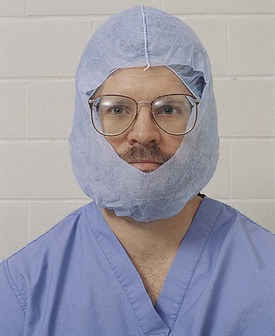Chapter 6 Other surgical attire includes hair coverings, masks, shoe covers, gowns, and gloves. Hair is a significant carrier of bacteria; when left uncovered, it acts as a filter and collects bacteria. Because shedding from hair has been shown to affect the surgical wound infection rate, complete coverage is necessary. Caps should completely cover all hair, and masks should cover the mouth and nostrils. Sideburns and beards require hoods (Fig. 6-1) for complete coverage. Skullcaps that fail to cover the side hair above the ears and the hair at the nape of the neck should not be worn. Masks constructed from lint-free material containing a hydrophilic filter web sandwiched between two outer layers should be worn whenever entering a sterile area. Their major function is to filter and contain droplets of microorganisms expelled from the mouth and nasopharynx during talking, sneezing, and coughing. Masks must be fitted over the mouth and nose and must be secured in a manner that prevents venting. The dorsal aspect of the mask is secured by shaping the reinforcing top edge tightly around the nose. Although it has traditionally been recommended that all individuals entering restricted areas of the operating room suite wear a mask when open sterile items and equipment are present, a recent study found no difference in surgical site infection rates when nonscrubbed operating room personnel did not wear a face mask (Webster et al, 2010). Surgical gowns may be reusable and made of woven materials (usually cotton), or they may be disposable. A recent study found no difference in contamination and infection of the surgical site between fabric and nonfabric scrubs (Burgatti and Lacerda, 2009); however, another study found that single-use gown and drape sets provide the highest cost/benefit rates in a human hospital setting (Baykasoglu et al, 2009). Disposable (single-use) gowns are nonwoven and are made directly from fibers rather than yarn. Loosely woven, all-cotton fabric, type 140 muslin commonly is used to make reusable gowns. This fabric is instantly permeable to bacteria when it becomes wet. A more expensive alternative, 270 pima cloth that has been treated to produce a durable, water-repellent finish, provides a better bacterial barrier. Fifty/fifty polyester/cotton blend cloth is available as a tightly woven fabric that resists bacterial penetration. Laundering woven gowns widens the fabric pores, diminishing their effectiveness as microbial barriers. Nonwoven gown materials include olefins and polyesters. The number of microorganisms isolated from the surgical environment is lower when disposable, nonwoven materials are used. Three main developments in surgical hand antisepsis have occurred in the past decade. These include (1) no longer using scrub brushes (Fig. 6-2), (2) the introduction of alcohol rubs (Box 6-1), and (3) a reduction in the duration of the scrub. In veterinary schools, instructions for surgical hand antisepsis have, until recently, included scrubbing the hands and arms with a brush. This practice is no longer recommended because studies have determined that scrubbing hands and arms results in skin damage and increased bacterial counts. Scrubbing with a brush has been demonstrated to remove epidermal layers, increase shedding of bacterial squamous cells, increase (not decreases) microbial counts, and change microbial flora, Thus, most experts agree that the time-honored convention of vigorously scrubbing off the uppermost layers of skin with a brush is not only unnecessary, but also unwise. Investigators in one study concluded that nail brushes and nail picks used during surgical hand scrubs do not decrease bacterial numbers and are unnecessary (Tanner et al, 2009). In this study, the following three surgical hand scrub protocols were compared: chlorhexidine only; chlorhexidine and a nail pick; and chlorhexidine and a nail brush. No statistically significant differences in bacterial numbers were found between any two of the three intervention groups.
Preparation of the Surgical Team
Surgical Attire
Surgical Scrub
Scrub Technique
Preparation of the Surgical Team




